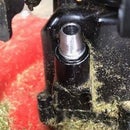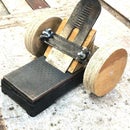Introduction: Copier Reductions and Enlargements Done Right
Getting the right size of reduction or enlargement on a copier the first time should not be difficult in principle, but secretaries always ask me to do it for them.
The challenge for this Instructable is to enlarge the Christmas Pageant graphic near to the black pen cap to fit the box at the left of the photo. It would be possible to make a series of copies at different sizes and hope for the best. It is better to calculate the enlargement or reduction needed and get it right the first time.
Step 1: Measure the Original
You will need to use a calculator, and they do not handle fractions without first converting to decimals. Save yourself some trouble and measure the graphic in millimeters. Leave a little margin on each side of the original. With a margin, the long measurement of the graphic is 72 mm.
Step 2: Measure the Space for the Graphic
Get a measurement of the box or space into which the graphic must fit. The photo shows the measurement for the short dimension of the box as 82 mm. Although not shown, the long dimension of the box was 94 mm.
The plan is to fit the graphic to the long dimension of the box. The formula involves the dimension of the space available divided by the size of the original. In this case, that is 94 divided by 72. The answer is 1.31. Move the decimal point and that is a 131 percent enlargement. Set the copier to enlarge to 131 percent and make a copy of the original.
Step 3: Success
Here you see the enlarged graphic fitted into the box for it. In the upper left you see the original graphic.
After making the enlargement (or reduction) trim it away from the rest of the paper with a scissors. Cover the paper edges with frosted tape so they do not show when you make copies of the enlarged graphic embedded in your greeting card or newsletter.
The box to receive this graphic is not of the same proportions as the original graphic. That is often the situation. The original graphic is lower and longer than the box for it. Check the enlargement or reduction ratios on the vertical dimensions and the horizontal dimensions. In this case, the one used (horizontal dimensions) was 131 percent. The ratio not used was 195 percent (vertical dimensions). Had 195 percent been used for the ratio of enlargement, the horizontal part of the graphic would have extended beyond the borders allowed for it. Always use the ratio that involves fitting the larger dimension of the original to the space available for it and let the other fall where it may. You will have a little white space (as above and below this newly enlarged graphic), but that is fine.
Experiment with this process once or twice to make certain you understand it, and everyone in your office will consider you an absolute genius.













